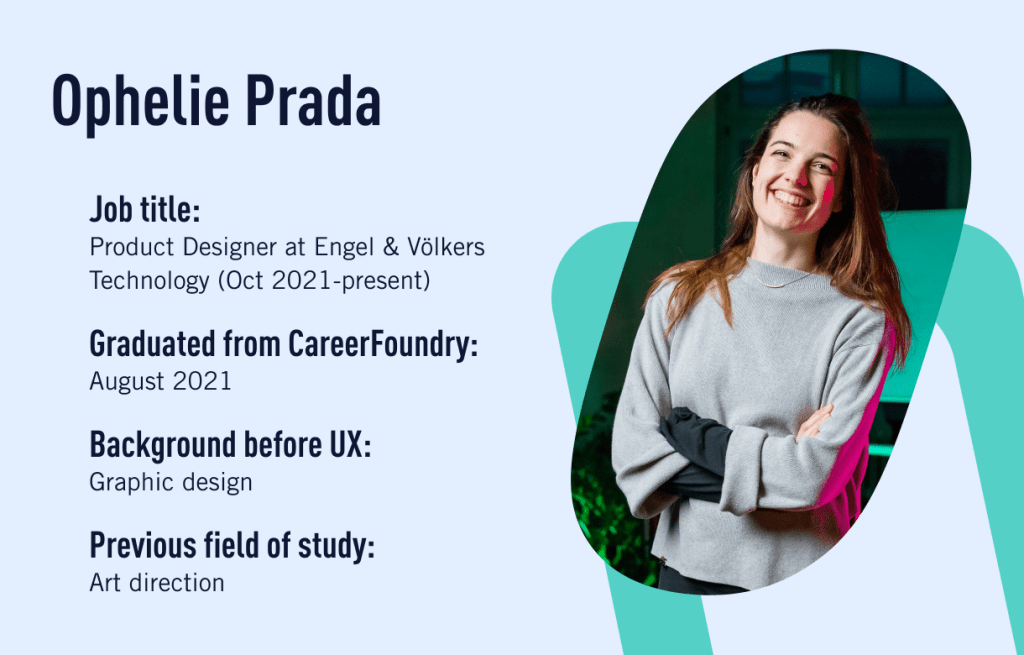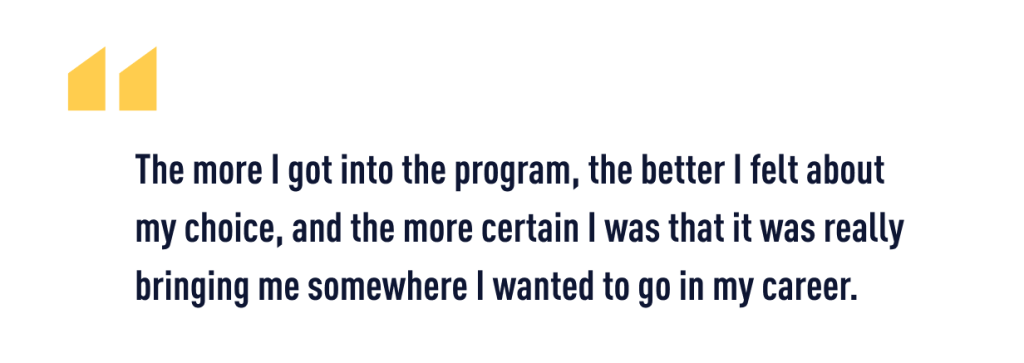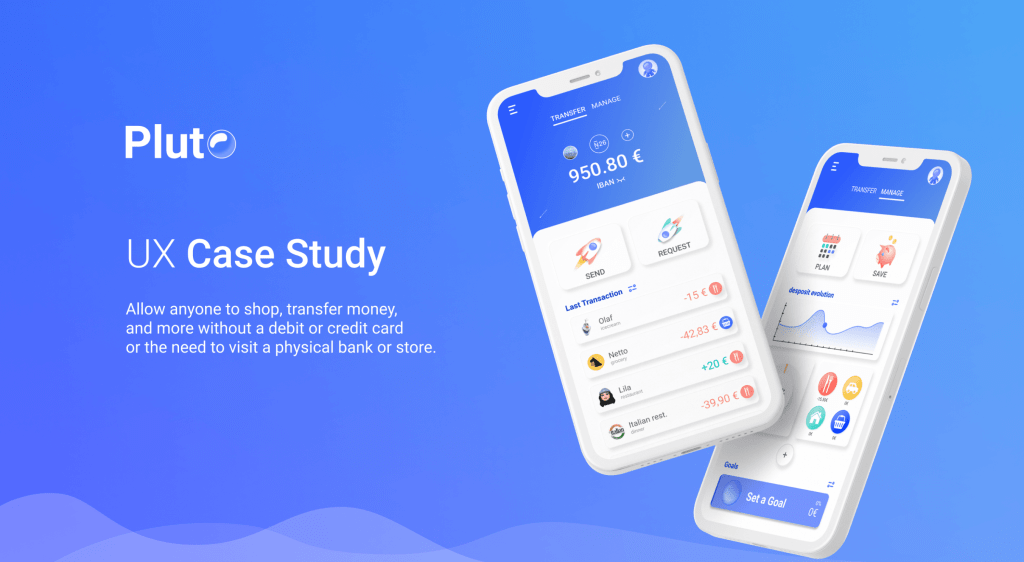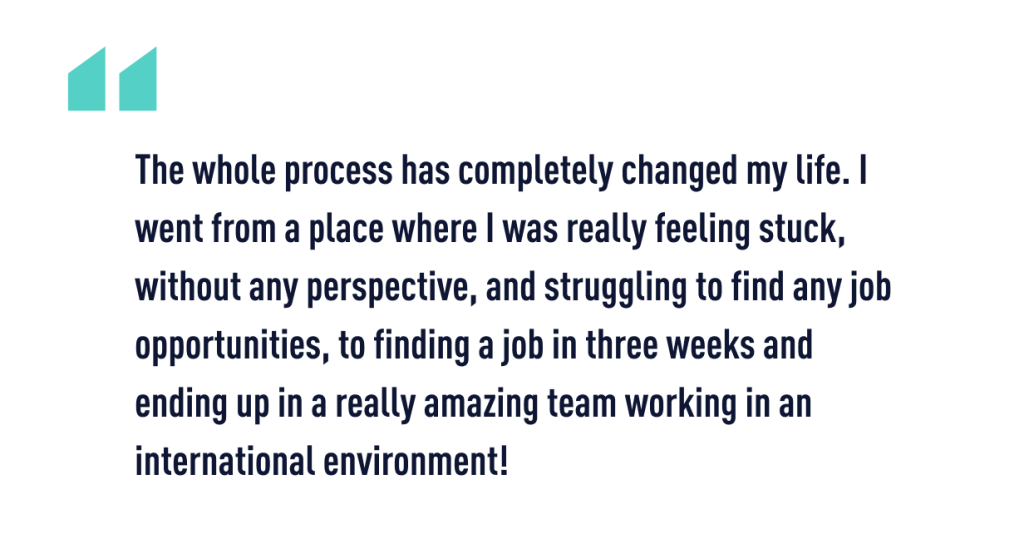
Did you know that if you’re unemployed in Germany you can take a career-change program at CareerFoundry for free with a Bildungsgutschein? A Bildungsgutschein is an educational voucher issued by the Agentur für Arbeit (the German Jobcenter). Once approved by the jobcenter, the voucher enables unemployed residents of Germany to learn new, valuable, in-demand skills for free!
That’s exactly what Ophélie did. When she started to feel unfulfilled in her freelance career as a graphic designer, she decided to change career paths. Equipped with her Bildungsgutschein, she completed the UX Design Program at CareerFoundry and landed a new job as a product designer—all within six months. Quite the fairytale career change!
In this article, she shares her experience going through the process with the Agentur für Arbeit, discusses what studying UX design with CareerFoundry was like, and tells all about her role as a product designer!
You can also hear more from Ophelie talking about her career change journey in this video:
Originally trained as a graphic designer, Ophélie also has a master’s degree in art direction and studied UX design with CareerFoundry in 2021. Summing up her career change experience, it’s clear from the start of our chat that she has no regrets:
“The whole process has completely changed my life! I really love what I’m doing now. It sounds super cliché, but I think UX/UI is what I was meant to do.”
Feeling stuck in her graphic design career, Ophélie realized she wasn’t challenged by her work and she didn’t really see how her career could evolve:
“I started thinking how I could broaden my skillset. How could I make myself more attractive on the job market? I started looking at UI design first and I saw everywhere, even for graphic design roles, that employers were asking for skills in Figma.
So I started learning Figma by myself and while doing that, mainly on YouTube, I began to see more and more videos and content about UX design. I found it really interesting. I found a video from AJ&Smart where they explained how you can retrain as a UX/UI designer with CareerFoundry with the help of the Agentur für Arbeit and a Bildungsgutschein.”
If you’re wondering at this point how the process with the Agentur für Arbeit works, here’s how Ophélie went through it:
“There was a very detailed page on the CareerFoundry website about the process. I downloaded the application pack for the UX Design Program and I followed everything step-by-step.
I first had to reach out to the Agentur für Arbeit and “pitch” my career change to them. For example, I had to explain why I wanted to study with CareerFoundry and how it would make sense in my personal career path to do so.
I had an appointment over the phone with a consultant there, and then I got an email saying that I would receive the Bildungsgutschein, which would also be emailed to me. They sent it over, and then I just had to send the voucher to CareerFoundry so that I could get started with the next cohort of students!”
And with that, she was ready to embark on her career change journey! Ophélie is originally from France but now lives in Berlin. Being a non-native German, we asked her if she had any advice to share with others who are in a similar situation and considering going through the process with the Agentur für Arbeit?
“Prepare yourself and make sure you know why you’re doing it. To convince the Agentur für Arbeit about your career change you need to be sure what you’re doing for yourself and why you want to do it. And then go for it!
I don’t know if my story is a fairytale, but it was so smooth and easy and the people I talked to were so helpful and nice. Maybe it’s not the case for everyone but I would say it’s definitely worth it.’
Moving on to talk about her CareerFoundry experience, Ophélie confessed that the beginning of the program was relatively smooth but later became more intense. Nevertheless, she still felt extremely fulfilled taking the course—particularly when it came to creating her first industry portfolio:
“Having my portfolio done at the end was definitely a highlight. Being able to produce this portfolio and think ‘I did all of that!’ was really satisfactory.”


To see the full case study and view more of Ophélie’s work, head to her portfolio.
One of the great benefits of studying with CareerFoundry is the dual mentorship model. Students are paired with not one, but two industry experts—a tutor and a mentor. When we asked Ophélie about her relationship with her instructors, she had plenty of praise to share about her mentor, David Wenk:
“The good thing is that David has a very different personality to me; he’s more entrepreneurial and very ambitious. Talking with him helped me set higher standards for myself.
I’m still so thankful for his ability to give straightforward feedback in a transparent way, and never judge. David has a way of getting straight to the point, very respectfully, so you never take feedback personally.
He taught me how to handle feedback in a very healthy way, which is extremely helpful right now in my professional life. In my previous graphic design job, there was a lot of feedback around creativity and personal opinions. Whereas with the CareerFoundry program and UX/UI design, the feedback is more pragmatic which is easier to understand and action.”
We were lucky enough to also meet with David recently and learn about his own career change story! From construction manager to UX student to Product Design Lead, you can hear more about David, and how he became a CareerFoundry mentor in this video: From CareerFoundry Student To UX Design Lead
Equipped with a new portfolio and copious amounts of advice from her mentor, Ophélie went on to complete the UX Design Program and begin her job search. Looking for her first role in the industry, things moved very quickly for her:
“I did the program from March to August, and then I published my portfolio and shared it on LinkedIn. Two or three days afterward my current design lead at Engel & Völkers contacted me via LinkedIn. I had an interview with him and my senior colleague, and before I knew it on October 1 I was starting my new job!”

Telling us all about her role as a product designer at a large real estate company, Ophélie had some great insights to share:
“I work for both B2B and B2C products at Engel & Völkers Tech. Right now, I’m focused on B2C (business-to-consumer) product design which I prefer. Branding has a bigger importance in B2C and thanks to my graphic design background it suits me more. B2B products are also very interesting and challenging in their own way though!
I’m working with different products, have ownership of my B2C design system, and I’m working very closely with the content developer and product manager.
A big part of my work is maintaining the design system and adding new elements, which is really interesting because you need to do a lot of research on design systems and UI components. It’s very precise work, almost like you’re becoming an expert by really digging into the small UI components such as input fields or primary buttons.
Another essential part of my job is communicating with developers so that we don’t have a quality gap in our work, and also doing a lot of QA (quality assurance). So there is this constant exchange with developers and the product manager to be sure that our team is building the best product that we can.”
If you’re curious to learn more about product design, and the similarities and differences it has with UX design, we recommend this article: UX Design vs. Product Design: What’s the Difference
Or perhaps you’ve been inspired by Ophélie’s story and are thinking a career in product design could be a good fit for you too! Book a call with a program advisor at CareerFoundry to start taking your next steps toward a career in tech. Or, why not try this free introductory short course in UX design?
To hear from other CareerFoundry graduates who have studied with a Bildungsgutschein and made a career change into tech, check out these success stories:
- Retraining as a UX Designer in Berlin: How the German Jobcenter Helped Me Change Careers
- Pauline’s Career Change to Web Developer: How She Discovered the Reward of Working in Tech
- How To Become a Product Designer: Florian’s Career Change Story
